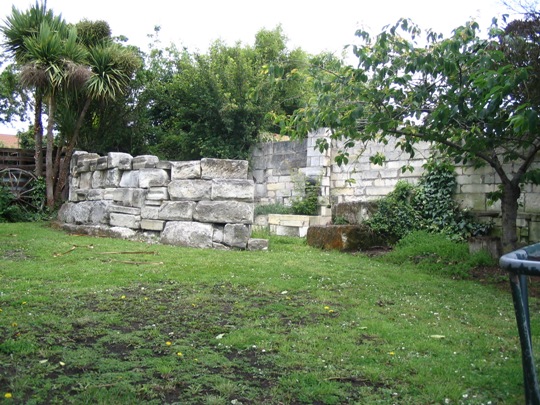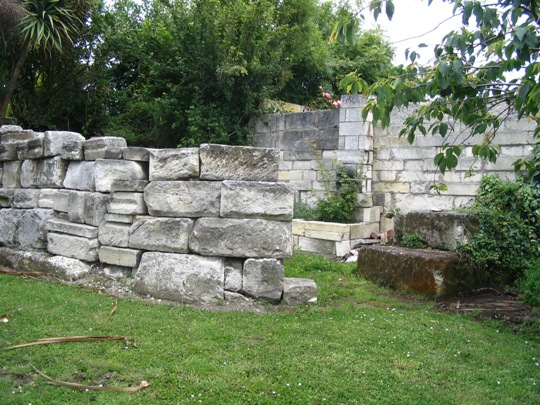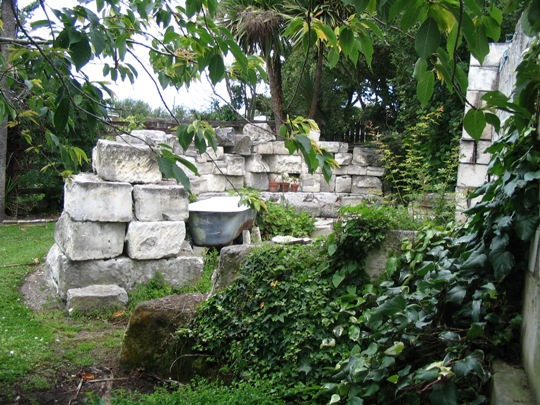From 1867 until its demolition in 1909 James Hassell’s wind-powered flour mill was a landmark building that could be seen from all over Oamaru. Eight storeys high and built of limestone blocks it was a relatively unusual structure but not a very successful mill. All that remain are the foundations, now located on behind a private residence, which have historical and archaeological significance and are a reminder of Hassell’s enterprising business and of the history and significance of flour milling in nineteenth century Oamaru. James Lloyd Hassell (d. 1896) was born in Surrey, migrated to Australia where he took by the Mooraby run in Victoria, before coming to New Zealand in 1859. He purchased the Oamaru Run from the Filleul brothers, living in Oamaru before shifting on to the run. He was active in the community, in business and in flour milling. Hassell was an elder of St Paul’s Presbyterian Church, and a member of the Oamaru Harbour Board. In his later years, he shifted to Waimate, where he died in 1896. Hassell erected his first flour mill – the Oamaru Steam Mill (also called Oamaru Flour Mill) – on the corner of Thames and Wear Streets in 1864. The mill was managed by George Bruce, who later took it over. The flour was branded ‘Oamaru Silk-dressed.’ By January 1867, Hassell had turned his attention to building another mill, this time, one powered by wind. Hassell’s mill attracted attention outside of Oamaru. Wellington’s Evening Post reported that ‘[t]here is at present being erected near Oamaru a windmill, a building which, says the local journal, is a novelty in the district, if not in the colony.’ The paper reported that, ‘finding it difficult or impossible to obtain a proper supply of water to drive the machinery of his projected new flour mill, Mr. Hassell determined on availing himself of a mill to be worked by another element. No time has been lost, and the building is already in progress.’ The North Otago Times reports that the windmill was in a prominent position on the hill overlooking the Public Gardens Reserve. The mill included a timber mill-store ‘of considerable dimensions’ and a tower of Oamaru stone. The windmill was complete by December 1867, and was ‘one of the most prominent features of the landscape.’ The windmill was, according to the newspaper, the first erected in Otago. The Oamaru stone tower was 65 feet high [19.8 metres (m)] from the base to the top, with another ten feet [3 m] added by the metal cap. The tower had eight floors. The inside diameter of the basement storey was 21 feet [6.4 m], narrowing to 12 feet [3.6 m] at the top. Adjoining the mill was the flour store, 32 by 18 feet [9.7 by 5.5 m] and 34 feet high [10.3m], and capable of storing 500 tons [508 metric tons] of flour. The machinery was supplied by Whitemore and Sons of Suffolk. James Calder built the tower, superintended by a Mr Campbell. The basement storey had grain bins, with elevators raising the grain to the top storey. The wheat was screened and then carried to the floor below. The wind driven machinery included a perpendicular shaft that drove the whole system. The wheat was processed as it passed through the floors. On the fourth floor from the top, there were three pairs of millstones. The bottom storeys of the tower were used for storage. The mill had a producing power of 1500 tons [1524 metric tons] a year, with a 16 horse power steam engine working the stones when there was insufficient wind. The water for the steam engine was forced from the creek below the mill by a hydraulic ram. The mill was not very successful, the wind power being unreliable. The Otago Witness reported ‘although it is called a windmill, it is really a windmill assisted by steam; or, perhaps, rather, a steam mill assisted by wind. So uncertain is the latter source of power that it cannot be said to do more than a fourth of the work.’ In 1883, the land on which the mill stood was transferred to the mortgage holder. The mill closed in 1886, but the building itself remained a landmark in Oamaru. The mill site was offered for sale in 1898, but had still not sold in 1901 – 2 acres with ‘Cottage and Old Windmill Tower.’ The property was sold in two lots, one to Sergeant O’Grady bought the property in 1901, the other to George Gardiner in 1904. By 1904 there were discussions about pulling down the mill. Old residents opposed the idea, recognising its picturesque significance. The mill was pulled down in 1909, but has remained in the public’s imaginations. In later years, the land on which Hassell’s windmill stood has become a quiet residential neighbourhood, with the pile of stones, and probably some subsurface remains marking the site of this early landmark. In 2015, the remains of Hassell’s windmill serve as a reminder of this landmark building, the importance of flour milling in nineteenth century Oamaru, and the association with entrepreneur and pastoralist James Hassell.



Location
List Entry Information
Overview
Detailed List Entry
Status
Listed
List Entry Status
Historic Place Category 2
Access
Private/No Public Access
List Number
7314
Date Entered
4th April 1996
Date of Effect
4th April 1996
City/District Council
Waitaki District
Region
Otago Region
Extent of List Entry
Extent includes part of the land described as Sec 19 Blk LXXXVIII Town of Oamaru (RT OT225/243), Otago Land District, and the remains of Hassell’s Windmill thereon. (Refer to the extent map tabled at the Heritage List/ Rārangi Kōrero Committee meeting on 11 February 2016).
Legal description
Sec 19 Blk LXXXVIII Town of Oamaru (RT OT225/243), Otago Land District
Stay up to date with Heritage this month
